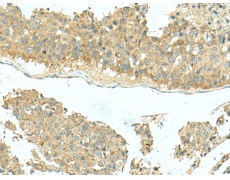技术规格
Background:
Killer cell immunoglobulin-like receptors (KIRs) are transmembrane glycoproteins expressed by natural killer cells and subsets of T cells. The KIR genes are polymorphic and highly homologous and they are found in a cluster on chromosome 19q13.4 within the 1 Mb leukocyte receptor complex (LRC). The gene content of the KIR gene cluster varies among haplotypes, although several "framework" genes are found in all haplotypes (KIR3DL3, KIR3DP1, KIR3DL4, KIR3DL2). The KIR proteins are classified by the number of extracellular immunoglobulin domains (2D or 3D) and by whether they have a long (L) or short (S) cytoplasmic domain. KIR proteins with the long cytoplasmic domain transduce inhibitory signals upon ligand binding via an immune tyrosine-based inhibitory motif (ITIM), while KIR proteins with the short cytoplasmic domain lack the ITIM motif and instead associate with the TYRO protein tyrosine kinase binding protein to transduce activating signals. The ligands for several KIR proteins are subsets of HLA class I molecules; thus, KIR proteins are thought to play an important role in regulation of the immune response.
Applications:
ELISA, WB, IHC
Name of antibody:
KIR2DL5A
Immunogen:
Synthetic peptide of human KIR2DL5A
Full name:
killer cell immunoglobulin like receptor, two Ig domains and long cytoplasmic tail 5A
Synonyms:
CD158F; KIR2DL5; KIR2DL5.1; KIR2DL5.3
SwissProt:
Q8N109
ELISA Recommended dilution:
5000-10000
IHC positive control:
Human liver cancer
IHC Recommend dilution:
40-200
WB Predicted band size:
41 kDa
WB Positive control:
Human plasma solution
WB Recommended dilution:
1000-5000


 购物车
购物车 帮助
帮助
 021-54845833/15800441009
021-54845833/15800441009
